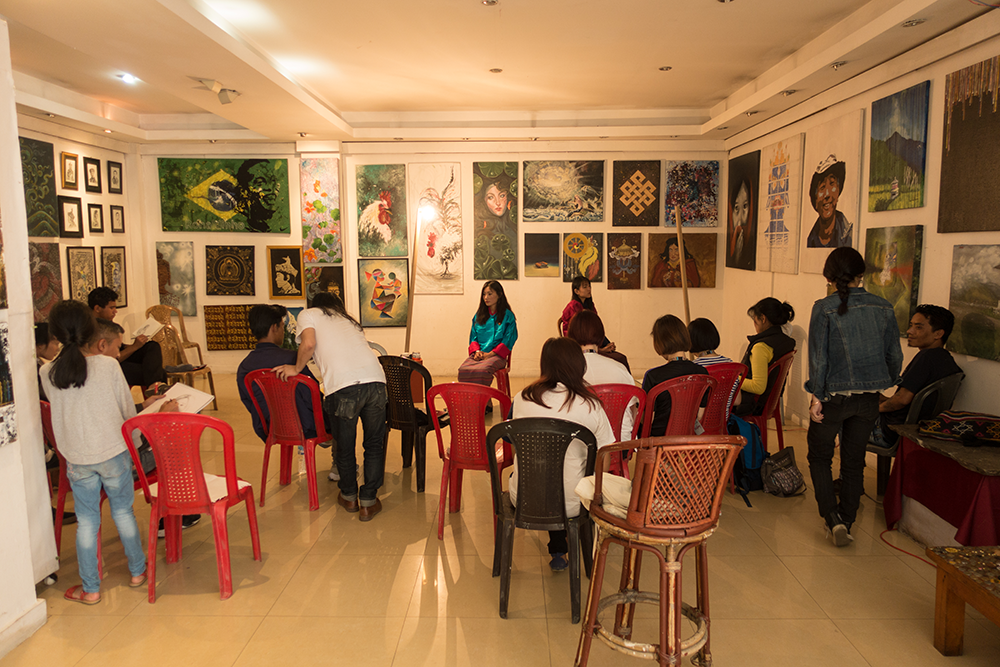Last week marked the successful collaboration with Drukasia for Sketch Bhutan 2018, a unique sketching tour. Similar to the previous year, participants from Australia and Singapore joined the all-inclusive tour, engaging in the art of sketching and painting while exploring the captivating landscapes of Bhutan over a 7-day period.
Flight to Bhutan via Drukair
Tiger nest sketch
Tashichho Dzong, Thimphu
Chimi Lhakhang , Punakha
Thimphu from Namgay Heritage
Live drawing of Sangay
Chimi Lhakhang, Punakha (36.5 cm x 24 cm)
Punakha Dzong, 37.5cm x 21 cm)
Shop houses opposite the post office. (26 cm x 18 cm)
Tashichho Dzong 27 cm x 12.5 cm
The backstory to and Foundation of Sketch Bhutan:
Around three years ago, the journey began with a month-long volunteer experience in Bhutan, where I served as an art coach in primary schools and organizations.
Taught drawing to Shaba Primary and donated some art supplies to their art club.
During this period, I initiated the Thimphu chapter of Urban Sketchers, an effort to foster local artistic communities. However, the internal conflict arose when faced with the question of encouraging art as a hobby or a potential livelihood for Bhutanese children. This dilemma inspired the inception of Sketch Bhutan, aiming to bring tourists to Bhutan not just for sketching and touring but for meaningful interactions with local artists.
The founding members of Urban Sketchers, Thimphu
At Shaba Primary, I brought them art supplies and sketchbooks sponsored by Bynd Artisan and a few friends.
Unique Focus of Sketch Bhutan
In contrast to conventional sketching experiences, Sketch Bhutan distinguishes itself by not solely emphasizing technical competencies. The primary goal is to offer participants the perfect travel sketching experience, allowing them to immerse themselves comfortably in the environment. This is facilitated by the presence of a professional tour guide and driver, providing a harmonious on-location group sketching experience.
Sketch Bhutan 2017
Highlights of Sketch Bhutan 2018:
The tour showcased various highlights, including discovering a new sketching and painting spot at Tashichho Dzong. VAST Bhutan graciously hosted the group, with local students acting as models. Noteworthy moments included a spontaneous encounter with local children offering candies during sketching in Thimphu and the exploration of color theory and watercolor techniques in Punakha. The tour concluded with a visit to the iconic Tiger Nest at Paro.
Painting Tashichho Dzong
Another successful run of portrait drawing at VAST Bhutan
Sangay and her friend Tshsten were our beautiful models
The friendly children in Thimphu.
Punakha Dzong. The most beautiful Dzong in Bhutan
Next Sketch Bhutan and Leadership Transition:
The future of Sketch Bhutan hinges on the interest of at least four participants who can register through the Drukasia tour agency. Bhutan's esteemed artist, Rajesh, a co-founder of VAST Bhutan, will take the lead in guiding future sketching sessions. Interested participants are encouraged to contact Drukasia for more information.
Phyllis sketching up at Tiger's Nest
Rajesh, one of the finest artists in Bhutan will be leading Sketch Bhutan tours. Contact Drukasia to book your next sketching tour.
Learnings and Reflections: The narrative outlines the evolution of Sketch Bhutan over multiple trips, emphasizing personal growth and learning:
1st time:
The enchantment with Bhutan's landscape and the realization of a wish to paint the place.
An interesting exchange - my sketches featured on Drukasia's corporate calendar in return for a two-week trip to Bhutan.
Paintings featured in Drukasia's calendar
2nd time:
Solo painting trip.
A solo painting trip led to unique encounters and opportunities, including a commissioned painting for Drukair and participation in a group show in Singapore..
Group show with Asha Karma and other VAST artists.
3rd time:
A more extended stay in Bhutan involved teaching and volunteering at various schools.
Immersive experiences in local life and the founding of the Urban Sketchers, Thimphu chapter..
Teaching basic of drawing at VAST Bhutan
Assisted in founding the Urban Sketchers, Thimphu chapter. The subsequent year saw the founding members of Urban Sketchers, Thimphu, receiving invitations to participate in the Urban Sketchers Symposium held in Singapore.
Look for the Bhutanese in the group !
4th time:
The initiation of Sketch Bhutan in collaboration with Drukasia, involving eight special participants.
Confronting challenges in running a successful traveling workshop, touching upon aspects such as cost, preparation, marketing, logistics, and teaching materials.
Sketch Bhutan 2017
5th time:
Second Sketch Bhutan.
Successful handover of Sketch Bhutan to Bhutanese artist Rajesh.
Operations continue with increased frequency and the passing on of responsibilities.
Reflections on the impact of interactions with romance and the realization of a 'role-reversal' effect, gaining insight into personal predicaments and solutions.





























